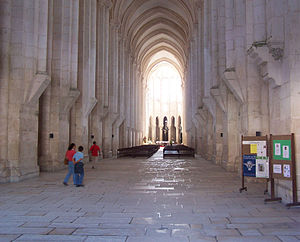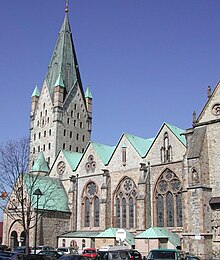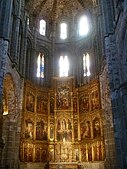|
Romano-Gothic Romano-Gothic is a term, rarely used in writing in English, for an architectural style, part of Early Gothic architecture, which evolved in Europe in the 12th century from the Romanesque style, and was an early style in Gothic architecture. In England "Early English Gothic" remains the usual term. The style is characterized by rounded and pointed arches on a vertical plane. Flying buttresses were used, but are mainly undecorated. Romanesque buttresses were also used. Romano-Gothic began to use the decorative elements of Gothic architecture, but not the constructional principles of more fully Gothic buildings. However, the walls did start to become thinner by using some pointed arches and ribbed vaults to distribute weight more evenly. [1] Combining ribbed vaults and the Romanesque tradition, the cathedrals of Angers (1149–1159) and Poitiers (1162) are examples of a transitional Gothic style, more austere and less well lit. Especially in Germany and the Low Countries, the term is used of relatively late buildings in a cautious provincial version of Gothic. The late-Romanesque style of the Rhineland has often been called Romano-Gothic.[2] GroningenIn the northern provinces of the Netherlands, especially Groningen, many churches are built in this style. The Romano-Gothic style period is from 1250 until 1350. Typical for this style are the walls and gables of brick that are richly decorated with recesses and patterns of bricks. An early example of this group is found in Leermens, where in c. 1250 a new choir was built to a Romanesque church. In this early stage of Romano-Gothicism only round-topped arches were used. In the interior the choir has a mellon-vault, a typical property of Romano-Gothic churches. A later variant of Romano-Gothicism features pointed arches, like at this church in Stedum. Note that many arches are purely decorative.
Rhineland, GermanyThe late-Romanesque style (German: Spätromanik) of the Rhineland has often been called Romano-Gothic as well. This can particularly be seen in Limburg Cathedral in Limburg an der Lahn which combines the round Roman arch and the Gothic ribbed vault, and is one of the most complete creations of Late Romanesque architecture. It was printed on the reverse of the 1,000 Deutsche Mark note from the second series, which was in circulation from 1960 to 1989. The cathedral was recently renovated and painted to reflect its original appearance.
Other examples of a mix between Romanesque and Gothic stylePaderborn, Germany Paderborn Cathedral is a hall church (i.e. with three naves instead of one) completed in 1270 in a transitional Romanesque-Gothic style. It is covered with a greenish copper roofing. The 93m high bell tower dates from the 12th century and is characterised by the 18 niches on each of its facade, as well as four roofed turrets at each corner. The crypt, with a length of 32 metres, is one of the largest in Germany, and contains the relics of St. Liborius. Kołbacz, PolandThe Cistercian abbey in Kołbacz includes a Romanesque-Gothic church (1210–1347). Its one of the oldest brick churches in Pomerania. Sandomierz, PolandDominican Church and Convent of St. James in Sandomierz made in the 13th century. The oldest church made by brick in Poland. Cremona, ItalyThe Cremona Baptistery (Italian: Battistero di Cremona) is a religious edifice in Cremona, northern Italy. It is annexed to the city's Cathedral. Built in 1167, it is characterized by an octagonal plan, a reference to the cult of St. Ambrose of Milan, symbolizing the Eight Day of Resurrection and, thenceforth, the Baptism. The edifice mixes Romanesque and Lombard-Gothic styles, the latter evident in the preference for bare brickwork walls.
See alsoGallery
Notes
External links
|





















